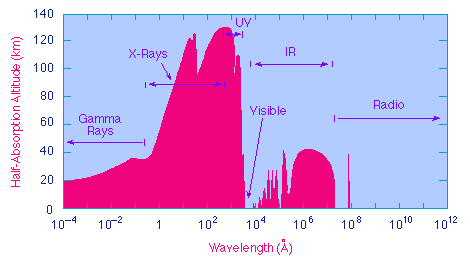
other Wavelengths
 |
Observations at other Wavelengths |
Recall our earlier discussion of atmospheric windows, as summarized in the following figure.
 |
Except for visible and rf frequency ranges, the atmosphere absorbs very strongly and serious astronomy at other wavelengths requires observations from orbiting platforms above the Earth's atmosphere.
The ability to routinely put such observatories in orbit has led to entirely new fields of astronomy devoted to observations at wavelengths other than visible. The following table summarizes some of the characteristic phenomena that are studied at various wavelengths.
(Table adapted from http://instruct1.cit.cornell.edu/~tlh10/lec12.htm.) Here is a link to NASA SkyView, which allows you to obtain views of different parts of the sky at different wavelengths.
Here is an Overview of the sky at various observational wavelengths. and here is a movie sequence of a galaxy morphing its perceived shape from spiral to almost elliptical as the wavelength is varied. This link to an example of the Trifid Nebula as seen at a normal range of wavelengths and through a filter that passes only light near the H-alpha Balmer frequency illustrates dramatically the observational differences at different wavelengths.